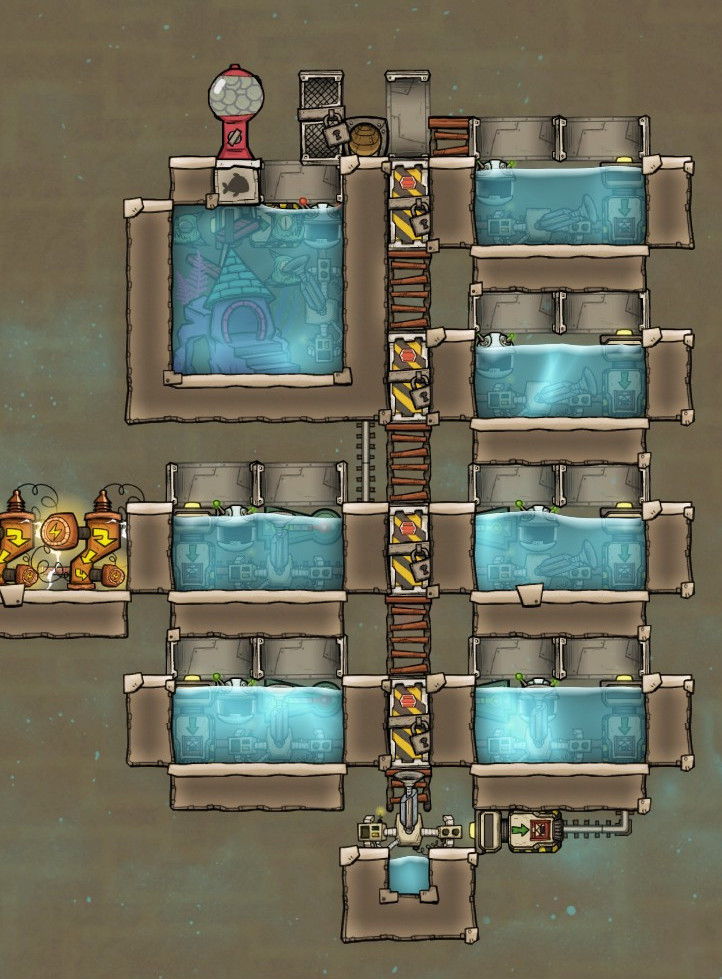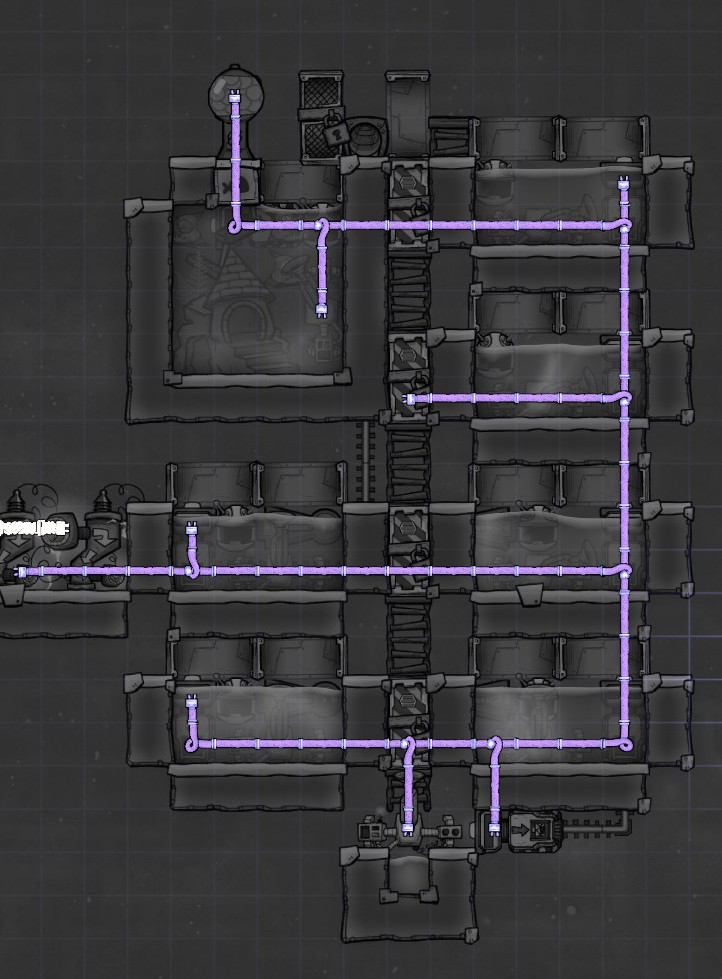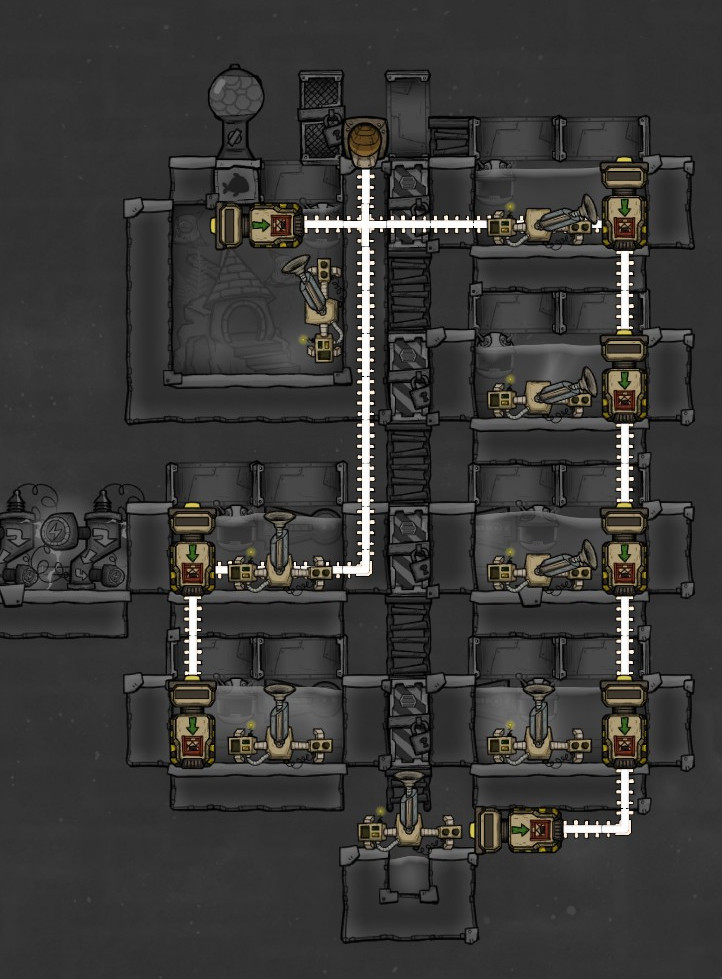Introduction
As of the Packed Snacks update (11/16/2023), Pacu ranching mechanics have changed. No longer are we able to infinitely pack Pacu into a single tile of liquid and starve them for endless quantities of free, sustainable filet. While many other methods of sustainable food production also exist, Pacu have long been one of the simplest and most effective to utilize, and with the new changes to Pacu and critter happiness mechanics you may be wondering how to redesign your Pacu ranch to adapt.
In this guide, I have provided all the important information you’ll need to know to redesign your Pacu ranch, or to build a new one from the ground up. I’ll also provide a ranch design that I’ve created after experimenting with the changes that you may find helpful in designing your own.
This guide mostly covers everything new to the Packed Snacks update. Many other resources for ranching Pacu are available, and although parts of them may be deprecated, I would still recommend giving them a look for other concepts and ideas. Magialisk’s guide to Fully Automated Infinite Pacu Ranching covers some useful concepts I don’t cover here, including pathing restrictions and liquid stacking. If you’d prefer something in video form, I’ve found GCFungus’s Tutorial Bite for Pacu on YouTube to be useful as well.
Important Mechanics
Part of this information is sourced from the patch notes for the Packed Snacks update.[forums.kleientertainment.com]
Pacu, like all critters, now have four happiness tiers, as listed below:
- 4 or more Happiness: Happy, 1.5 cycles/egg reproduction rate (33%/cycle)
- 0 to 3 Happiness: Satisfied, 15 cycles/egg reproduction rate (7%/cycle)
- -1 to -9 Happiness: Glum, 15 cycles/egg reproduction rate (7%/cycle) and reduced metabolism
- -10 or less Happiness: Miserable, no egg production and reduced metabolism
- For breeder Pacu to grow a population, we need to keep their happiness at 4 or higher.
- If we want starved Pacu to lay an egg before death, we need to keep their happiness at -9 or higher to avoid them becoming miserable.
Below are all the happiness modifiers that can affect adult Pacu, and the amount of happiness they provide.
- Tame (-1): Tamed Pacu innately have -1 Happiness.
- Ate from Feeder (+5): Pacu that have consumed food from a feeder in the last two cycles gain +5 Happiness.
- Cozy (+1): Pacu that have used the new Aquatic Fort building in the last cycle gain +1 happiness.
- Confined (-10): Pacu that are in fewer than 8 tiles of liquid (or flopping around outside of liquid) get -10 happiness and -100% reproduction rate. Importantly, this reproduction penalty remains even if happiness is above -10.
- Crowded (-X): Has a slightly more complex happiness affect, and I will cover it in detail below.
If you didn’t read the above list thoroughly, let me be clear: NEVER PUT PACU IN 7 TILES OF LIQUID OR LESS IF YOU WANT THEM TO LAY EGGS. Even if their happiness is increased through feeding, they will not lay eggs while confined.
Crowding mechanics changed a bit this update, and for anyone who isn’t familiar with them, here’s the short version:
- Every 8 tiles of liquid in a pool provides space for one pacu to be comfortable.
- Exceeding this ratio provides all Pacu in the pool with the Crowded affect.
- Pacu get -1 happiness from Crowded for each Pacu in excess of the comfortable ratio.
For example, 16 tiles of liquid provides space for two Pacu. Crowding the pool with 3 Pacu will make each of them get -1 happiness from Crowding.
While we can’t pack an endless number of Pacu into a ranch anymore, the new changes to crowding do allow us to pack extra Pacu into a starvation tank without preventing them from laying eggs. For optimal space usage, 9 starved Pacu can be put in an 8-tile liquid tank before adding another makes them all Miserable (-1 happiness from Tame, -8 Happiness from each other Pacu for a sum of -9). An additional Pacu can then be added for every 8 tiles of additional liquid in the tank, so it is more space-efficient to have lots of small tanks than one large tank for a starvation ranch.
As a side note before we move on, you can use the Aquatic Fort in 9 tiles of liquid to increase the starved Pacu limit to 10, although I didn’t end up doing this in my design.
Since there are very few options for increasing Pacu happiness (we can’t use the Critter Fountain, to my knowledge), we’re limited in how much Crowding we can do in breeding tanks if we want to maximize how many eggs we produce with our space. However, the Aquatic Fort does allow us to pack an extra Pacu into a breeding tank for a few extra eggs per cycle.
- Using multiple, smaller tanks is more space-efficient for starvation ranching, but always use at least 8 tiles of liquid per tank. 9 Pacu can fit into an 8-tile tank for the optimal starvation size.
- Pacu in breeding tanks can’t be crowded, so use 8 tiles of liquid per Pacu as was the case before the update.
- The Aquatic Fort building can be used to squeeze an extra Pacu into the same space, for either starvation or breeding tanks, while still allowing egg production.
Obviously you don’t want to be feeding Pacu in a starvation ranch, but I should note here that the Pacu’s diet has changed this update:
- Pacu can consume 7.5kg/cycle of Algae, down 95% from before (140kg/cycle), making feeding them algae much more viable and sustainable in the long term.
- Pacu can consume 1kg/cycle of seeds (1 seed = 1kg), which has tripled from before (0.3kg/cycle), making feeding them seeds more challenging but not inefficient, especially if you have excess seeds.
- Pacu no longer include decorative seeds, such as Bluff Briars, in their diet, so you don’t have to worry about accidentally feeding them nonrenewable seeds.
Ranch Design




A couple notes:
- A sweeper and loader for the eggshells, polluted dirt and Pacu Filet is not included in the diagram. Add those in range of the Conveyor Chute at the top to pipe them to your kitchen for grilling, or elsewhere as needed.
- This design can be stacked vertically, and you can add as many more starvation tanks below as you want, copying the bottom half as many times as desired. Each starvation tank provides enough kcal per cycle in cooked seafood for about half a duplicant.
I describe how the ranch works below. Before that, here are the quick configuration details for the parts and pieces:
- The Critter Sensor is set to send Green if below 3. Critters are counted, eggs are not.
- The Conveyor Loader accepts Fry Eggs, Gulp Fry Eggs, Tropical Fry Eggs, Pacu Filet, and (optionally) Polluted Dirt – you may not want the polluted dirt collecting wherever you’re sending the Pacu Filet and Eggshell, and it won’t emit polluted oxygen while in the breeder tank.
- The fish feeder can be filled with fish food of your choice.
- All of the starvation tanks have the same configurations:
- The Critter Sensor is set to send Green if below 9. Critters are counted, eggs are not.
- The Conveyor Loader accepts Fry Eggs, Gulp Fry Eggs, Tropical Fry Eggs, and Pacu Filet.
All output from the ranch – eggs, filet, etc. – is shipped to the top of the ranch and dropped at the conveyor chute. When the pacu hatch, they flop into one of the tanks depending on each tank’s capacity. The filet and other outputs of the ranch can be collected by a sweeper and conveyor loader and shipped elsewhere in your base.
The breeding tank has a capacity of 3. You can build a larger one if you want or need it; I chose this size because it fits in well with the vertical starvation tank arrangement.
If there are fewer than 3 Pacu and/or eggs in the breeding tank, access to the starvation tanks is blocked off, and the breeding tank is opened to allow delivery of another Pacu.
Similarly, when each starvation tank has 9 Pacu and is at capacity, access to the tank is blocked off so that Pacu will navigate to other nearby tanks instead.
If both tanks on a level are full, the door in the middle opens to allow Pacu to drop down to the next layer. This can repeat for as many tanks as you want, as long as the Pacu can all fall down one main shaft.
When all the tanks are full, any excess Pacu that hatch will fall into the excess pit at the bottom of the ranch. These extra Pacu won’t lay eggs since they’re confined, and can be freely killed or relocated by hand if you need their filet early. Otherwise, they will starve and die on their own timeline.
The pneumatic doors covering the tanks are necessary for the critter sensors, so they only detect pacu in their tank and don’t pick up critters in a larger room. If you wish, you can replace the outer doors with tiles; I chose doors as it allows for easier duplicant access.
Conclusion
More Guides:
- Oxygen Not Included: Automatic Kitchen with Freezer
- Oxygen Not Included: Fully Automated Hatch Ranching 2021
- Oxygen Not Included: Air Conditioning Plant (Simple and Compact Design)
